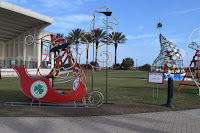 Jacksonville
Beach, Florida has more to offer than just a pretty beach (although that was
the main reason we stopped). The city by the sea is host to many attractions
that include a museum, art gallery and outdoor amphitheater called Seawalk
Pavilion.
Jacksonville
Beach, Florida has more to offer than just a pretty beach (although that was
the main reason we stopped). The city by the sea is host to many attractions
that include a museum, art gallery and outdoor amphitheater called Seawalk
Pavilion.
My traveling
buddies and I happened to be lucky enough to witness a unique display at the
Seawalk Pavilion. I didn’t know what it was at the time of our visit, but I
knew it was something special.
It was
around one o’clock on a December afternoon when we pulled into a parking lot
off 1st Street in Jacksonville Beach, FL. We happened to park next
to some sort of Winter light display that reminded me it was still the
holiday’s. The warmth of Florida with its lush green vegetation and colorful
flowers made it easy for me to forget that a mere 24-hours earlier I had passed
out Christmas gifts and ate turkey and pumpkin pie.
 Once we had
removed ourselves from the vehicle and did some leg stretches we started across
the street to make our way to the beach. I couldn’t wait to get my toes in the
sand! As we approached the Winter display I noticed a variety of holiday
favorites covered in lights; a gingerbread house, a huge Christmas tree and a
sled to name a few. What added a unique flare to this Winter exhibit was that
red lifeguard chairs were adapted into the display and had been transformed
into a beautifully sculptured piece of holiday joy. The attraction was
stunning.
Once we had
removed ourselves from the vehicle and did some leg stretches we started across
the street to make our way to the beach. I couldn’t wait to get my toes in the
sand! As we approached the Winter display I noticed a variety of holiday
favorites covered in lights; a gingerbread house, a huge Christmas tree and a
sled to name a few. What added a unique flare to this Winter exhibit was that
red lifeguard chairs were adapted into the display and had been transformed
into a beautifully sculptured piece of holiday joy. The attraction was
stunning. The Seawalk
Pavilion is host to the annual Winter lights festival, called Deck the Chairs. The festival started in
2013 and began out of a desire to enhance the holiday spirit in Jacksonville
Beach.
The Seawalk
Pavilion is host to the annual Winter lights festival, called Deck the Chairs. The festival started in
2013 and began out of a desire to enhance the holiday spirit in Jacksonville
Beach.
I think what
impresses me the most about this event is the thought and care that has gone
into putting it together. It’s safe to say that Deck the Chairs serves many purposes: it entertains the public, it
boosts collaboration between businesses and artists, and all proceeds go to an
organization dedicated to protecting the beach; the Jacksonville Beach Life
Saving Corps.
Since its
launch, Deck the Chairs has become a
non-profit entity whose mission, according to its website, “is to build
community pride and strengthen local economy while fostering the arts and
public safety through a lighted lifeguard chair display.” (http://deckthechairs.org/about)
Genius. The
idea to turn something so familiar and comforting as a lifeguard chair into a
work of art that enhances holiday spirit and brings joy to others is pure
genius.
 The Seawalk
Pavilion not only hosts the annual Winter lights festival but also hosts a
variety of events throughout the year that include a classic car cruise, family
movie night, and the summer jazz concert series. If you would like more
information on these events and when they are taking place, I encourage you to
visit http://www.jacksonvillebeach.org/visitors/special-events.
The Seawalk
Pavilion not only hosts the annual Winter lights festival but also hosts a
variety of events throughout the year that include a classic car cruise, family
movie night, and the summer jazz concert series. If you would like more
information on these events and when they are taking place, I encourage you to
visit http://www.jacksonvillebeach.org/visitors/special-events.
Jacksonville
Beach is one of those cities where you can leave your worries at the city line
and enjoy some peace and serenity. I am so glad we were lucky to be able to
stop for a while and take in some of the pleasures the city by the sea has to
offer.
Text and Photos Copyright 2016 Jodi Hughey











